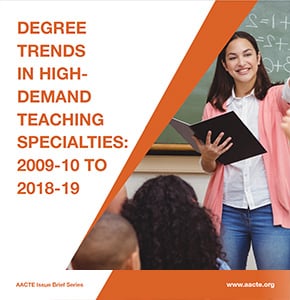AACTE Issue Briefs Examine Education Degrees Trends and Future Implications for Teacher Workforce


The American Association of Colleges for Teacher Education (AACTE) released today two new issue briefs, Institutions Offering Degrees in Education: 2009-10 to 2018-19 and Degree Trends in High-Demand Teaching Specialties: 2009-10 to 2018-19. The reports examine education trends through an analysis of the number of institutions awarding degrees in education and the imminent threat of increased teacher shortages , particularly in high-demand areas. The findings raise significant concerns about the nation’s future capacity to produce new teachers and other education professionals to meet the diverse needs of students, families, and communities.
The Institutions Offering Degrees in Education report describes the number of institutions awarding degrees in education from 2009-10 to 2018-19, and offers a table listing of institutions awarding any degree in education by state and institution type during this period. It reveals that, while the number of institutions offering degrees in education has been stable, the number of institutions with small programs, defined as awarding 30 or fewer degrees and certificates annually, rose by 21%. These institutions currently make up one-third of all colleges and universities awarding education degrees. Of critical importance is that the average number of education graduates across all institution types fell by 24% from 2009-10 to 2018-19.
“While these are challenging times for colleges of education, they are not insurmountable. AACTE members are committed to producing high quality teachers and a diversified teaching workforce,” said AACTE President and CEO Lynn M. Gangone. “AACTE will continue to monitor these trends to keep its members and education community informed and to provide support during this critical time.”
Degree Trends in High-Demand Teaching Specialties examines degree production in high-demand fields, the number and type of institutions awarding degrees in high-demand specialties, and the racial/ethnic and gender profile of degree recipients in high-demand specialties, comparing these specialties to education overall and to all fields. With a focus on special education, mathematics and science education, English as a second language, and foreign language education, the study highlights these key findings:
- While general programs in special education remain popular, more students are choosing programs that concentrate on particular levels of education and on particular student conditions or attributes. Sub-specialties that gained graduates included special education for early childhood and elementary students and teaching students who have autism.
- The number of degrees conferred in mathematics and science education fell by 27% between 2009-10 and 2018-19. There were significant increases over the same period in the number of mathematics and science degrees conferred outside of schools, colleges, and departments of education, but demand for those graduates across the economy is likely to depress interest in teaching.
- The drop in the number of students earning degrees in foreign language education was matched by a similar decline in foreign language graduates outside of education.
- African American students are under-represented in special education relative to education graduates as a whole. This finding is particularly concerning given that African American K-12 students are among the most likely to receive special education services.
- English as a second language attracts a much larger proportion of Latinx students than education as a whole, but the number of Latinx students earning degrees in this specialty has declined since 2011-12.
- Foreign language education also attracts a high proportion of Latinx students, but the number of these students has declined by 39% since 2011-12.
The trends outlined in this issue brief suggest that K-12 schools will not be able to eliminate shortages simply by recruiting newly prepared teachers. Sustaining the educator workforce in these key areas will require a combined effort across K-12 and higher education to retain current teachers, prepare more teacher candidates in these specialties, and encourage students with mathematics, science and foreign language training and expertise to enter educator preparation programs and become teachers.
The reports are available for AACTE members at aacte.org.
Tags: AACTE online resources, content areas, higher education, research






